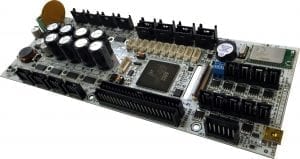GH Enterprise is an Italian company that is changing the industry with its SPEEDY board, a high performance controller board originally designed for 3D printers, but also used in CNC machines, laser engravers and robotic arms. The SPEEDY Board uses ST’s STM32F4 ARM ® Cortex ® M4 microcontroller, integrates a 3.5″ (480×320) display, acts as a Wi-Fi access point or HTTP Server, and includes a USB port, an SD Card reader, and customizable hardware and firmware. There are 18 digital inputs to control behavior, 8 analog inputs for sensors, and 10 digital output MOSFETs to control fans and other equipment. Thanks to its flexible board design, the SPEEDY Board accepts a wide power supply voltage range (15 – 40 Vdc), and integrates an uninterruptible power supply.
It is nowadays very common to use an Arduino board with an 8-bit microcontroller to control the above of applications. However, the ARM Cortex-M4 offers a much more powerful and versatile 32-bit architecture and GH Enterprise chose ST’s MCU because, according to their engineers:
The STM32F4 is the most advanced and powerful ARM Cortex-M4 MCU in the market. The chip allows us to reach high-performance real-time and high-resolution motion control, with the addition of Wi-Fi features, and a color touchscreen display like no one other in the 3D printing world.

ST ART (Adaptive Real-Time) Accelerator
This is made possible by the ST ART Accelerator found inside the STM32F4 MCU series. The accelerator allows instructions to be executed straight from the internal flash, solving the memory interface bottleneck faced by most fast MCUs and SoCs today. Flash is considered to be a slow internal memory, but it would be very inefficient to send instructions from the Flash to the SRAM because the latter is much smaller and adds latency. The ART Accelerator organizes the internal flash memory into slices of 128-bits, each containing on average five to six instructions, with a maximum of eight instructions. Fetching instructions from the flash requires four to eight CPU clock cycles. The ART Accelerator allows the CPU to execute the instructions contained in the 128-bit slices within the flash memory during those cycles, greatly optimizing CPU performance.
In addition, the STM32F4 devices contain a second accelerator dedicated to graphics. The Chrom-ART Accelerator, further freeing up CPU resources complements the chip’s LCD-TFT controller enabling the highest performing version of the STM32F4 to support an XGA (1024×768) screen at 20 frames per second with little to no impact on CPU performance. In the case of the SPEEDY Board, this means that the STM32F4 can support the touchscreen display while dedicating its CPU resources to offer great performance and a wide range of features. This represents a serious competitive advantage as GH Enterprise’s correspondent explains:
Thanks to the performance of the STM32F4 ARM Cortex-M4 MCU, several 3D printing manufacturers have already chosen to upgrade their electronic platform from Arduino to SPEEDY board.
GH Enterprise has also announced that it is already working on a future version of the SPEEDY board that will utilize an STM32F7 series ARM Cortex-M7 MCU for even higher performance and new features, such as the inclusion of a camera using ST’s Direct Camera Multimedia Interface (DCMI).
Check out the impressive technologies of GH Enterprise and their SPEEDY Board. You can also learn more about the STM32F4 family on STMicroelectronics’ website.
